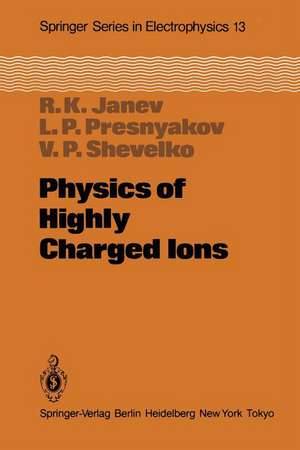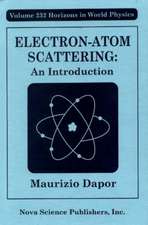Physics of Highly Charged Ions: Springer Series in Electronics and Photonics, cartea 13
Autor R.K. Janev, L. P. Presnyakov, V.P. Shevelkoen Limba Engleză Paperback – 7 dec 2011
Din seria Springer Series in Electronics and Photonics
-
 Preț: 389.49 lei
Preț: 389.49 lei - 15%
 Preț: 644.18 lei
Preț: 644.18 lei - 15%
 Preț: 653.79 lei
Preț: 653.79 lei - 15%
 Preț: 648.74 lei
Preț: 648.74 lei -
 Preț: 393.13 lei
Preț: 393.13 lei - 15%
 Preț: 645.47 lei
Preț: 645.47 lei -
 Preț: 389.11 lei
Preț: 389.11 lei -
 Preț: 380.45 lei
Preț: 380.45 lei -
 Preț: 384.09 lei
Preț: 384.09 lei -
 Preț: 394.29 lei
Preț: 394.29 lei - 15%
 Preț: 643.16 lei
Preț: 643.16 lei - 18%
 Preț: 730.35 lei
Preț: 730.35 lei - 15%
 Preț: 526.35 lei
Preț: 526.35 lei - 15%
 Preț: 638.11 lei
Preț: 638.11 lei -
 Preț: 390.63 lei
Preț: 390.63 lei - 15%
 Preț: 641.03 lei
Preț: 641.03 lei - 15%
 Preț: 637.46 lei
Preț: 637.46 lei -
 Preț: 396.24 lei
Preț: 396.24 lei -
 Preț: 395.09 lei
Preț: 395.09 lei -
 Preț: 381.81 lei
Preț: 381.81 lei -
 Preț: 395.47 lei
Preț: 395.47 lei - 15%
 Preț: 646.30 lei
Preț: 646.30 lei - 15%
 Preț: 633.35 lei
Preț: 633.35 lei -
 Preț: 383.93 lei
Preț: 383.93 lei - 15%
 Preț: 641.71 lei
Preț: 641.71 lei -
 Preț: 391.99 lei
Preț: 391.99 lei -
 Preț: 395.09 lei
Preț: 395.09 lei -
 Preț: 390.46 lei
Preț: 390.46 lei - 15%
 Preț: 641.53 lei
Preț: 641.53 lei - 15%
 Preț: 642.18 lei
Preț: 642.18 lei - 15%
 Preț: 642.18 lei
Preț: 642.18 lei - 18%
 Preț: 949.23 lei
Preț: 949.23 lei
Preț: 391.02 lei
Nou
Puncte Express: 587
Preț estimativ în valută:
74.82€ • 80.01$ • 62.38£
74.82€ • 80.01$ • 62.38£
Carte tipărită la comandă
Livrare economică 18 aprilie-02 mai
Preluare comenzi: 021 569.72.76
Specificații
ISBN-13: 9783642691973
ISBN-10: 3642691978
Pagini: 348
Ilustrații: X, 332 p.
Dimensiuni: 155 x 235 x 18 mm
Greutate: 0.49 kg
Ediția:Softcover reprint of the original 1st ed. 1985
Editura: Springer Berlin, Heidelberg
Colecția Springer
Seria Springer Series in Electronics and Photonics
Locul publicării:Berlin, Heidelberg, Germany
ISBN-10: 3642691978
Pagini: 348
Ilustrații: X, 332 p.
Dimensiuni: 155 x 235 x 18 mm
Greutate: 0.49 kg
Ediția:Softcover reprint of the original 1st ed. 1985
Editura: Springer Berlin, Heidelberg
Colecția Springer
Seria Springer Series in Electronics and Photonics
Locul publicării:Berlin, Heidelberg, Germany
Public țintă
ResearchCuprins
1. Introduction.- 1.1 General Overview.- 1.2 Basic Features of Highly Charged Ions and Their Interactions.- 1.3 Highly Charged Ions in Astrophysics.- 1.4 Highly Charged Ions in Controlled Thermonuclear Fusion Research.- 1.5 Highly Charged Ions in Accelerator-Based Physics and Other Research Fields.- 1.6 Scope of the Book.- 2. Structure and Spectra of Highly Charged Ions.- 2.1 General Properties of the Spectra.- 2.2 Satellites of the Spectral Lines.- 2.3 Classification of the States and Spectral Lines of Multiply Charged Ions.- 2.4 Relativistic and Radiative Effects.- 2.5 Decay of Excited Ionic States. Radiation and Autoionization.- 2.6 Static and Dynamic Dipole Polarizabilities of Multiply Charged Ions.- 3. Radiative Processes in the Continuous Spectrum.- 3.1 Bremsstrahlung.- 3.2 Photoionization and Photorecombination.- 3.3 Dielectronic Recombination.- 3.4 Autoionization.- 4. Electron Collisions with Highly Charged Ions: General Theory and Excitation Processes.- 4.1 Introductory Remarks.- 4.2 Basic Equations.- 4.3 Effective-Range Theory for Attractive Coulomb Field.- 4.4 Quantum Defect Method. The Seaton Theory.- 4.5 Correct Asymptotic Expansion. Influence of Dielectronic Recombination.- 4.6 Results of Calculations and Experimental Data.- 5. Electron-Impact Ionization of Highly Charged Ions.- 5.1 One-Electron Ionization. General Remarks.- 5.2 Exchange Effects in Ionization. The Peterkop Theory.- 5.3 Threshold Behaviour of the Cross Section.- 5.4 Quantum-Mechanical Methods for Ionization Cross Section Calculations.- 5.5 Classical and Semi-Empirical Formulae.- 5.6 Excitation-Autoionization.- 5.7 Experimental Data and Comparison with Theoretical Calculations.- 5.8 Analytic Approximations for the Quantum-Mechanical Cross Sections.- 6. Collisions of Atoms with Highly ChargedIons: General Theoretical Description.- 6.1 Two-Coulomb-Centre Problem.- 6.2 Close-Coupling Methods.- 6.3 Perturbation Methods.- 6.3.5 Second-Order and Related Approximations.- 6.4 Classical Descriptions.- 7. Collisions of Atoms (Ions, Molecules) with Highly Charged Ions: Charge-Transfer Processes.- 7.1 General Considerations.- 7.2 Charge Exchange at Low Energies.- 7.3 Electron Capture at Intermediate Energies.- 7.4 Electron Capture at High Energies.- 7.5 General Features of Single-Charge-Transfer Cross Sections.- 7.6 Single-Charge Transfer in Ion-Ion and Ion-Molecule Collisions.- 7.7 Multiple-Charge Transfer.- 8. Collisions of Atoms (Ions) with Highly Charged Ions: Excitation and Ionization.- 8.1 Basic Electron Transition Mechanisms.- 8.2 Excitation Processes.- 8.3 Single-Electron Ionization.- 8.4 Electron Loss and Stripping Processes.- 9. Auger, Inner-Shell and Related Processes.- 9.1 Collisional Auger Processes Involving Outer Shells.- 9.2 Inner-Shell Processes.- 9.3 Some Aspects of Quasi-Molecule and Quasi-Atom Formation in Heavy Ion Collisions.- 10. Rate Coefficients of Elementary Processes.- 10.1 Energy (Velocity) Distribution Function.- 10.2 Electron-Impact Excitation.- 10.3 Electron-Impact Ionization.- 10.4 Photorecombination.- 10.5 Dielectronic Recombination.- 10.6 Charge Transfer.- References.















